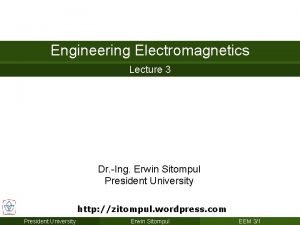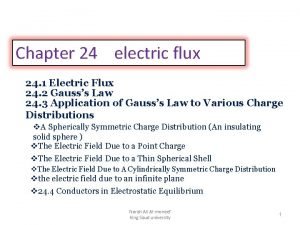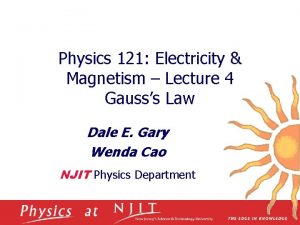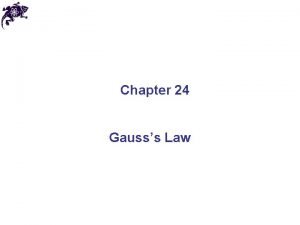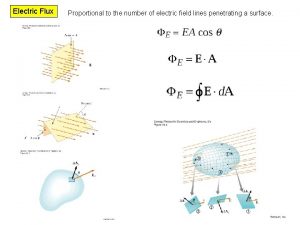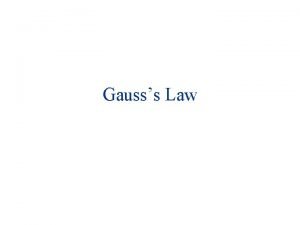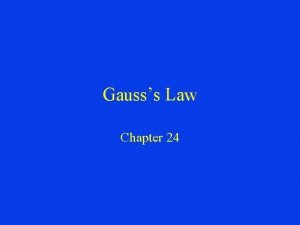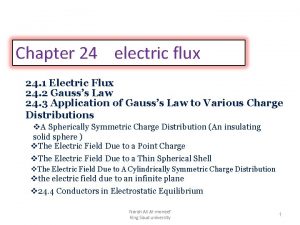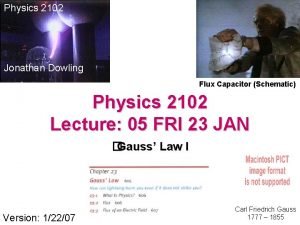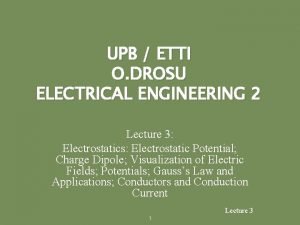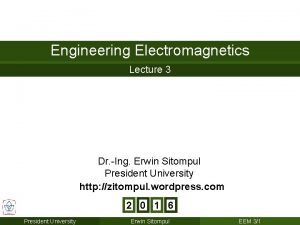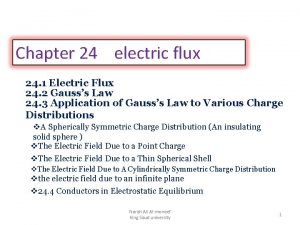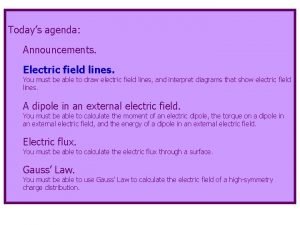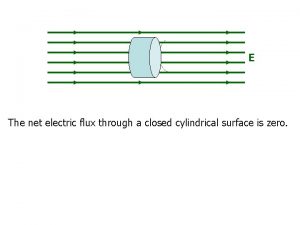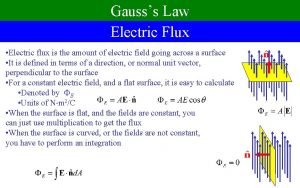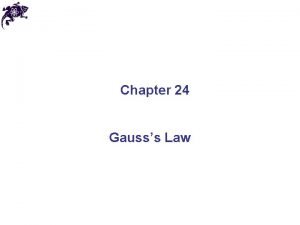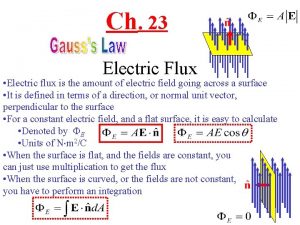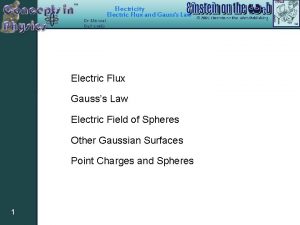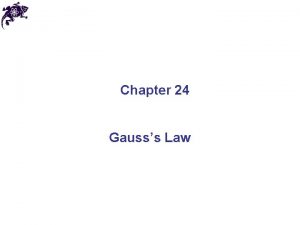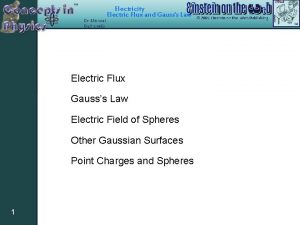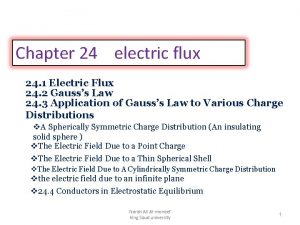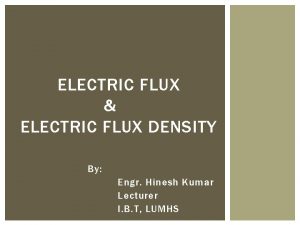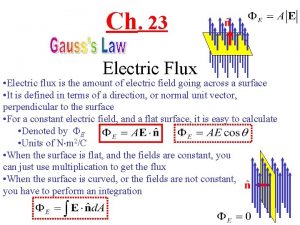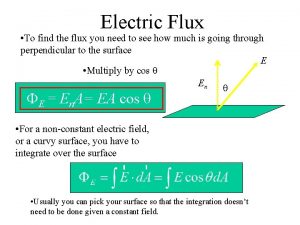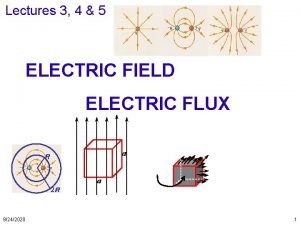Ch 23 Electric Flux Electric flux is the



















- Slides: 19

Ch. 23 Electric Flux • Electric flux is the amount of electric field going across a surface • It is defined in terms of a direction, or normal unit vector, perpendicular to the surface • For a constant electric field, and a flat surface, it is easy to calculate • Denoted by E • Units of N m 2/C • When the surface is flat, and the fields are constant, you can just use multiplication to get the flux • When the surface is curved, or the fields are not constant, you have to perform an integration

Warmup 03


Warmup 03

Solve on Board

Total Flux Out of Various Shapes A point charge q is at the “center” of a (a) sphere (b) joined hemispheres (c) cylinder. What is the total electric flux out of the shape? b a q q a q

Electric Flux (Hard example) A point charge q is at the center of a cylinder of radius a and height 2 b. What is the electric flux out of (a) each end and (b) the lateral surface? top s z • Consider a ring of radius s and thickness ds r a b b r q b a lateral surface

Gauss’s Law • No matter what shape you use, the total electric flux out of a region containing a point charge q is 4 keq = q/ 0. Why is this true? • Electric flux is just measuring how many field lines come out of a given region q • No matter how you distort the shape, the field lines come out somewhere • If you have multiple charges inside the region their effects add • However, charges outside the region do not contribute q 4 q 3 q 1 q 2

Warmup 03

Using Gauss’s Law to find total charge A cube of side a has an electric field of constant magnitude |E| = E pointing directly out on two opposite faces and directly in on the remaining four faces. What is the total charge inside the cube? A) 6 Ea 2 0 B) – 6 Ea 2 0 C) 2 Ea 2 0 D) – 2 Ea 2 0 E) None of the above a a a



Using Gauss’s Law to find flux A very long box has the shape of a regular pentagonal prism. Inscribed in the box is a sphere of radius R with surface charge density . What is the electric flux out of one lateral side of the box? Perspective view • The flux out of the end caps is negligible • Because it is a regular pentagon, the flux from the End view other five sides must be the same

Using Gauss’s Law to find E-field A sphere of radius a has uniform charge density throughout. What is the direction and magnitude of the electric field everywhere? • Clearly, all directions are created equal in this problem • Certainly the electric field will point away from the sphere at all points • The electric field must depend only on the distance • Draw a sphere of radius r around this charge • Now use Gauss’s Law with this sphere r Is this the electric field everywhere? a

Using Gauss’s Law to find E-field (2) A sphere of radius a has uniform charge density throughout. What is the direction and magnitude of the electric field everywhere? [Like example 23. 6] • When computing the flux for a Gaussian surface, only include the electric charges inside the surface r a r/a

Electric Field From a Line Charge What is the electric field from an infinite line with linear charge density ? L r • Electric field must point away from the line charge, and depends only on distance • Add a cylindrical Gaussian surface with radius r and length L • Use Gauss’s Law • The ends of the cylinder don’t contribute • On the side, the electric field and the normal are parallel

Electric Field From a Plane Charge What is the electric field from an infinite plane with surface charge density ? • Electric field must point away from the surface, and depends only on distance d from the surface • Add a box shaped Gaussian surface of size 2 d L W • Use Gauss’s Law • The sides don’t contribute • On the top and bottom, the electric field and the normal are parallel


Serway 23 -33 Solve on Board
 Magnetic retentivity
Magnetic retentivity Weber magnet
Weber magnet Electric flux density
Electric flux density Electric flux
Electric flux What is electric flux
What is electric flux Electric flux through a closed surface
Electric flux through a closed surface Flux capacitor schematic
Flux capacitor schematic In the figure the net electric flux
In the figure the net electric flux Fluxea
Fluxea Flux
Flux Electric field inside sphere
Electric field inside sphere Flux capacitor schematic
Flux capacitor schematic Electric flux density
Electric flux density Electric flux density
Electric flux density Electric flux
Electric flux Electric flux
Electric flux Net electric flux
Net electric flux Chapter 21 electric charge and electric field
Chapter 21 electric charge and electric field Potential and potential difference
Potential and potential difference Chapter 21 electric charge and electric field
Chapter 21 electric charge and electric field


